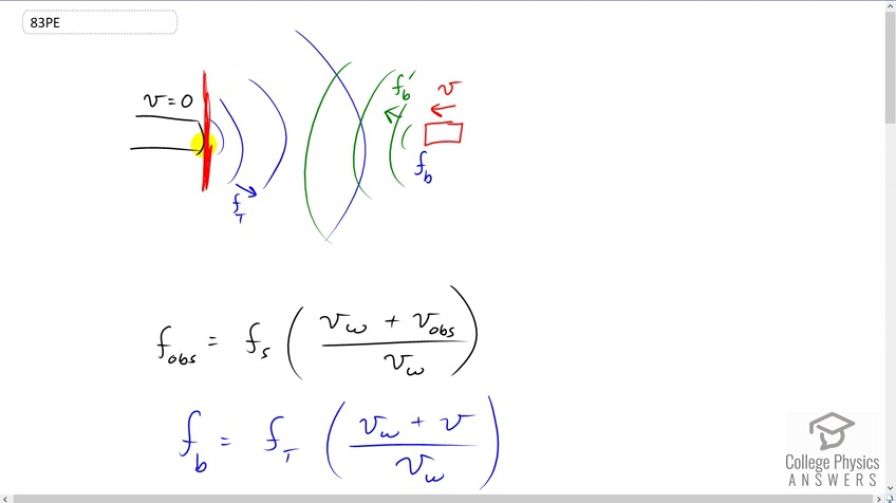Question
A diagnostic ultrasound echo is reflected from moving blood and returns with a frequency 500 Hz higher than its original 2.00 MHz. What is the velocity of the blood? (Assume that the frequency of 2.00 MHz is accurate to seven significant figures and 500 Hz is accurate to three significant figures.)
Final Answer
Solution video
OpenStax College Physics, Chapter 17, Problem 83 (Problems & Exercises)

vote with a rating of
votes with an average rating of
.
Calculator Screenshots
Video Transcript
This is College Physics Answers with Shaun Dychko. So, the ultrasound device is resting against a patient's skin that's here. And, it's beaming some ultrasound at some blood moving through a blood vessel here. And, we'll imagine that the blood vessel is going is going directly towards the ultrasound device. Now, the blood will notice an incoming frequency, and that frequency that the blood will perceive is going to be different from what is transmitted by the ultrasound device. So, we have the frequency transmitted here, written as F subscript T. And, the blood, we can imagine, is a moving observer towards this sound source. And so, I've written F subscript B to be the frequency perceived by the blood, so to speak. And then, the blood will be reflecting the sound. Now, because it's a moving source from that perspective, it's going to also shift the incident sound frequency. And, we'll call that Fb prime. So, there's two doppler shifts that are happening. There's one doppler shift which is the change in frequency that the blood receives due to the fact that the blood is a moving observer, and then furthermore, there's a second doppler shift when the blood essentially transmits or reflects this frequency. And, it's going to further shift this frequency due to the fact that it is now a moving source. Okay. So, we have this formula for frequency observed due to a moving observer. And, it's going to be the source frequency times the speed of the wave plus the speed of the observer divided by the speed of the wave. And, we use a plus sign when the observer is moving towards the source, as is the case here. And so, we'll substitute letters from the picture now into this formula. And so, this is Fb, the frequency observed by the blood, and it's going to be the frequency transmitted originally by the ultrasound device. And then, we multiply that by the speed of sound in tissue plus the speed of the blood divided by speed of sound. Okay. And then, we need to figure out what this Fb prime is, this frequency reflected from the blood, which will not be the same as the frequency of the blood receives, since the blood is now a moving source. And so, here is the doppler shift formula for frequency observed based on a moving source. So, it's going to be the source frequency times speed of sound divided by the speed of the wave minus the speed of the source. And, this minus is when the source is moving towards the observer. So now, replacing the things in this formula with variables from our picture, this is Fb prime that we're finding here, the frequency reflected from the blood. And, it's going to be the frequency that the blood receives that is the doppler shifted frequency that it receives times Vw over Vw minus the speed of the blood V. Now, this Fb we have to replace with this. So, we do that on this line. And so, the final frequency that the blood reflects, which is the frequency that the ultrasound will detect, since the ultrasound thing is not moving towards the blood, which is good, otherwise we'd have to add yet a third doppler shift. This Fb prime is going to be all of this. Now, a couple of convenient things happened. We have Vw's cancelling. Okay, only one convenient thing. And, once we have Fb prime is the frequency transmitted multiplied by the sum of these velocities divided by the difference. So now, our job is to solve this for V. So, we multiply both sides by the denominator, Vw minus V. And then, distribute into the brackets as well. We get Vw Fb prime minus V times Fb prime equals Ft times Vw plus Ft times V. Okay. And then, we want to collect the V terms on the same sides. We'll add V Fb prime to both sides. And then, we'll subtract Vw Ft from both sides. And also, switch the sides around. So, we have these two V terms together, and that's what's written here. And then, factoring out the V as well. So, we have V times Ft plus Fb prime equals Vw, factored out from these two terms, and so Vw is multiplied by Fb prime minus Ft. Then, divide both sides by this binomial. And then, you're left with this. So, the speed of the blood then is the speed of the ultrasound in the tissue times the measured frequency that's been reflected, Fb prime, minus the frequency originally transmitted divided by the sum of these frequencies. Now, the difference in frequencies, we're told, is 500 hertz. So, that's the numerator of this equation. And, the frequency transmitted is two megahertz. And so, now we also want to know what Fb prime is. And so, this is the frequency that is measured, which is 500 hertz more than what is transmitted. And rearrange this, if you like. And, you get 2,000,500 hertz. And, now we know all the things we need to know to plug into this formula. So, the numerator is 500 hertz, and the denominator is going to be the transmitted frequency of two megahertz plus Fb prime, which is 2,000,500 hertz. And, this fraction gets multiplied by the speed of sound in tissue, 1540 meters per second, and the speed of the blood must have been 0.192 meters per second.
